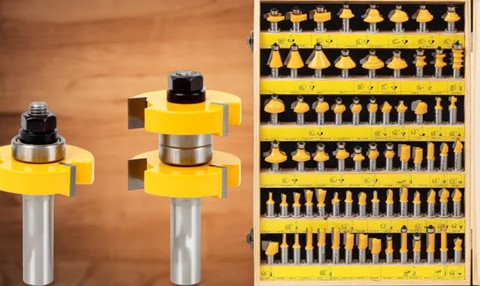Router Bits are vital tools in woodworking, allowing craftsmen to achieve intricate designs, precise cuts, and smooth finishes across a variety of materials. Whether you’re new to woodworking or a seasoned professional, knowing the components of router bits, identifying quality factors, and deciding between sets and individual bits can greatly enhance your projects. This article aims to explore the essential components of router bits, including what makes a high-quality bit and how to build the perfect Router Bit collection.
What Are the Components of a Router Bit
A router bit comprises several crucial parts, each with its own unique function and performance.
- Shank:
The shank is the cylindrical part of the bit that fits into the router’s collet. It is available in two common diameters: ¼ inch and ½ inch. While ¼-inch shanks are widely used, ½-inch shanks are preferred for their stability and reduced vibration during use. This added stability makes ½-inch shanks an excellent choice for heavy-duty projects and when precision is critical.
- Body:
The body is the main structure of the router bit, providing support to the cutting edges. Its design can vary depending on the bit’s intended use, with some bodies incorporating additional features like bearings or anti-kickback designs.
- Cutting Edges (Blades):
The cutting edges are the sharp parts of the router bit responsible for removing material from the workpiece. High-quality bits typically use carbide or high-speed steel (HSS) for the cutting edges. Carbide-tipped bits are especially durable, maintaining sharpness over prolonged use and ensuring clean, precise cuts.
- Bearing (if applicable):
Some router bits are equipped with a bearing that guides the bit along the edge of the material. This feature is particularly useful for achieving consistent cuts, especially when working with templates or edges. Bearings help maintain uniformity, reducing the need for additional adjustments or refinements.
A careful understanding of these components helps woodworkers choose the right router bit for their specific needs, ensuring better results and greater efficiency in their projects.
How to Choose Quality Router Bits
The quality of a router bit directly affects the outcome of a woodworking project. Investing in high-quality bits ensures durability, precision, and safety during operation. Here are key factors to consider when evaluating router bit quality:
- Material:
The material of the cutting edges significantly influences a router bit’s performance and longevity. Carbide-tipped bits are a superior choice compared to HSS bits due to their ability to maintain sharpness longer and withstand the demands of hardwoods and frequent use. While HSS bits may suffice for softwoods or occasional use, carbide-tipped bits are recommended for professional or intensive projects.
- Sharpness:
Sharp router bits are essential for achieving clean cuts and minimizing burn marks on the wood. Dull bits can lead to rough edges and require more effort, potentially damaging the workpiece or the Router Tool. Ensuring sharpness through regular maintenance or investing in bits that retain their edge is crucial.
- Balance:
A well-balanced router bit reduces vibration during use, which not only enhances safety but also results in smoother, more precise cuts. Balanced bits are particularly important for high-speed routers, where even minor imbalances can significantly affect performance.
- Anti-Kickback Design:
Some router bits feature an anti-kickback design that limits the depth of cut, reducing the risk of the bit catching on the material. This safety feature is especially valuable for beginners, providing an added layer of protection and ensuring consistent cuts.
Assessing these factors enables woodworkers to choose bits that meet their specific project needs and produce excellent outcomes.
Router Bit Sets vs. Individual Bits
When building a collection of router bits, woodworkers face a choice between purchasing comprehensive sets or selecting individual bits. Each approach has its advantages and considerations:
- Router Bit Sets:
For beginners, router bit sets are an excellent starting point. These sets typically include a variety of commonly used bits, offering versatility for different projects. By investing in a set, new woodworkers can experiment with various cuts and techniques without needing to purchase individual bits. However, the downside is that sets may include bits that are rarely used, potentially resulting in wasted resources.
- Individual Bits:
Experienced woodworkers often prefer to purchase individual bits tailored to their specific needs. This approach ensures that each bit in the collection serves a purpose, avoiding redundancy and maximizing value. As skills and project complexity grow, investing in specialized bits becomes more practical and cost-effective.
Both options have their place in a woodworker’s journey. Beginners can benefit from the versatility of sets, while experienced craftsmen may focus on building a curated collection of high-quality, purpose-specific bits.
Conclusion
The right router bits form the foundation of successful and rewarding craftsmanship, combining precision and versatility for countless tasks. Whether as a hobbyist or a professional, a thorough understanding of their components aids in selecting the ideal Router Bit Set, while recognizing quality indicators ensures both durability and reliable performance. Investing in high-quality router bits and practicing proper maintenance empowers woodworkers to achieve exceptional results, refine their skills, and approach projects with confidence.







Leave a Reply